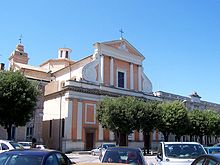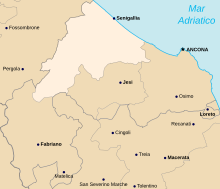Bishop of Senigallia
|
Diocese of Senigallia Dioecesis Senogalliensis |
|
|---|---|

Cathedral of Senigallia
|
|
| Location | |
| Country | Italy |
| Ecclesiastical province | Ancona-Osimo |
| Statistics | |
| Area | 580 km2 (220 sq mi) |
| Population - Total - Catholics |
(as of 2014) 130,714 120,205 (92%) |
| Parishes | 57 |
| Information | |
| Denomination | Catholic Church |
| Rite | Roman Rite |
| Established | 6th Century |
| Cathedral | Basilica Cattedrale di S. Pietro Apostolo |
| Secular priests | 72 (diocesan) 13 (religious Orders) |
| Current leadership | |
| Pope | Francis |
| Bishop | Giuseppe Orlandoni |
| Emeritus Bishops | Odo Fusi Pecci |
| Map | |
 |
|
| Website | |
| www.diocesisenigallia.it | |
The Diocese of Senigallia (Latin: Dioecesis Senogalliensis) is a Roman Catholic ecclesiastical territory in the Marche, Italy. It has existed since the sixth century. It is a suffragan of the archdiocese of Ancona-Osimo.
Historically and until 2000, the diocese of Senigallia was a suffragan of the archdiocese of Urbino. Currently in the diocese there are 1,414 Catholics for every priest.
The patron saint of Senigallia is St. Paulinus, whose body is preserved in the cathedral (as is attested for the first time in 1397). He is, therefore, not identical with Paulinus of Nola, nor is it known to what epoch he belongs. The first bishop of certain date was Venantius (502).
About 562 the bishop was St. Bonifacius, who at the time of the Lombard invasion was martyred by the Arians. Under Bishop Sigismundus (c. 590) the relics of St. Gaudentius, Bishop of Rimini and martyr, were transported to Senigallia.
Other bishops of the diocese are:
Under Bishop Antonio Colombella (1438), an Augustinian, Sigismondo Pandolfo Malatesta, lord of Senigallia and Rimini, angered by his resistance to the destruction of certain houses, caused the cathedral and the episcopal palace to be demolished. The precious materials were transported to Rimini and were used in the construction of S. Francesco (tempio Malatestiano). Under Bishop Marco Vigerio Della Rovere (1513) the new cathedral was begun in 1540; it was consecrated in 1595 by Pietro Ridolfi (1591), a learned writer.
...
Wikipedia
